Abstract
Inconsistent use of antiviral medications for the treatment of HIV may lead to the emergence of resistant strains in HIV-infected adults. Patterns of adherence with these drug regimens in adolescents remains unknown. Identifying nonadherence in HIV-infected patients to antiviral regimens and developing corrective measures could improve patient outcomes. This study was undertaken to understand adherence in HIV-infected youths engaged in care and to reduce patterns of nonadherence. A retrospective analysis of 25 charts (78%) of HIV-infected youths (n = 32, age 13 to 21 years) were consecutively reviewed from January 1993 to May 1998. Charts were reviewed for documentation of factors previously documented to be associated with adherence: housing stability, social support, prior sexually transmitted diseases (STDs) and/or pregnancy, HIV exposure category, number of clinic visits, number of pills per day, number of medications per day, knowledge of medication schedule, age, gender, race/ethnicity, health status as revealed by CD4 count and viral load, and recorded patterns of adherence to medications and clinic appointments. Thirteen of the 18 (72%) patients who were receiving antiretroviral medication were nonadherent. Sixty-seven percent of the females and 80% of the males reported missing doses. Housing instability (p = 0.031) and/or length of treatment with antiviral medications (months of treatment) (p = 0.043) were significantly correlated with nonadherence. The stability of the adolescents' living situations was the most significant correlate of medication adherence for this population of HIV-infected youth.
Full text
PDF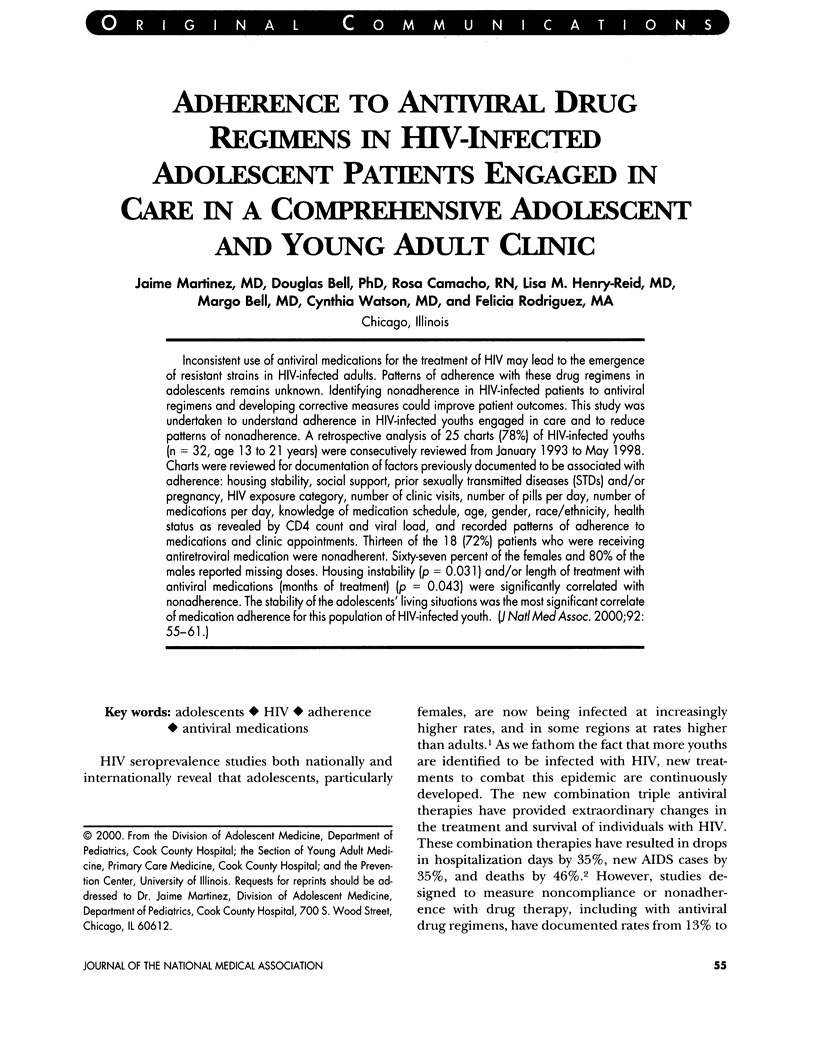
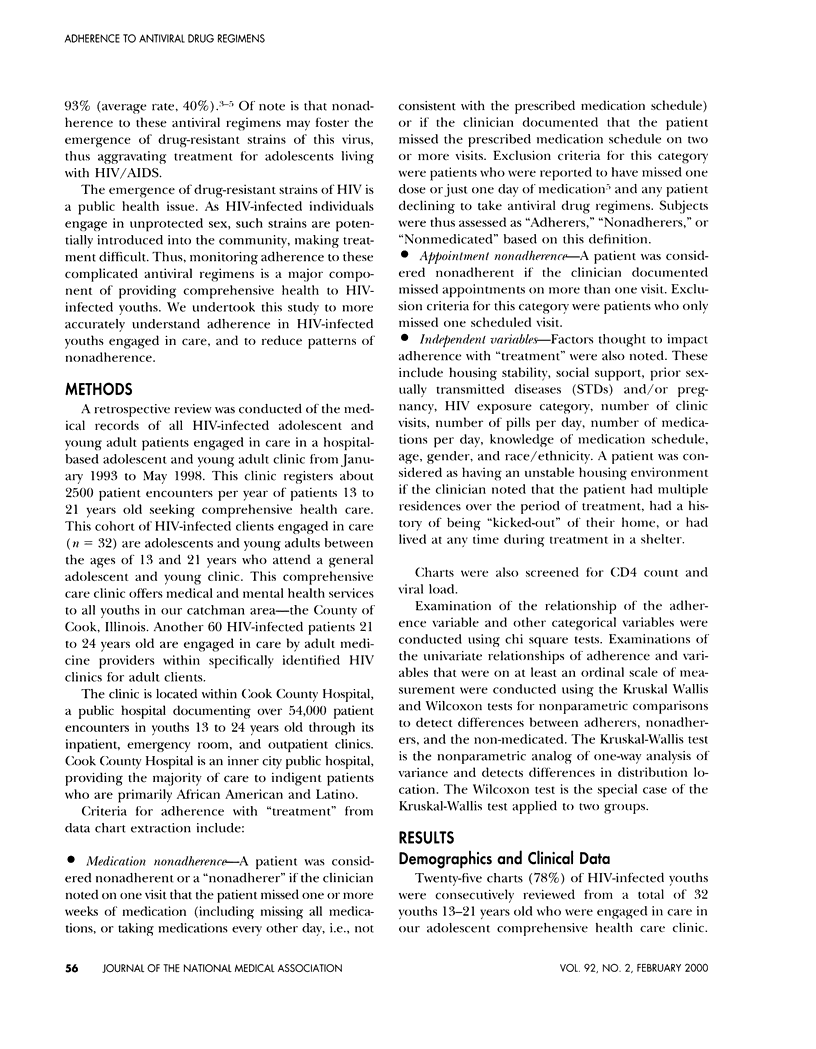

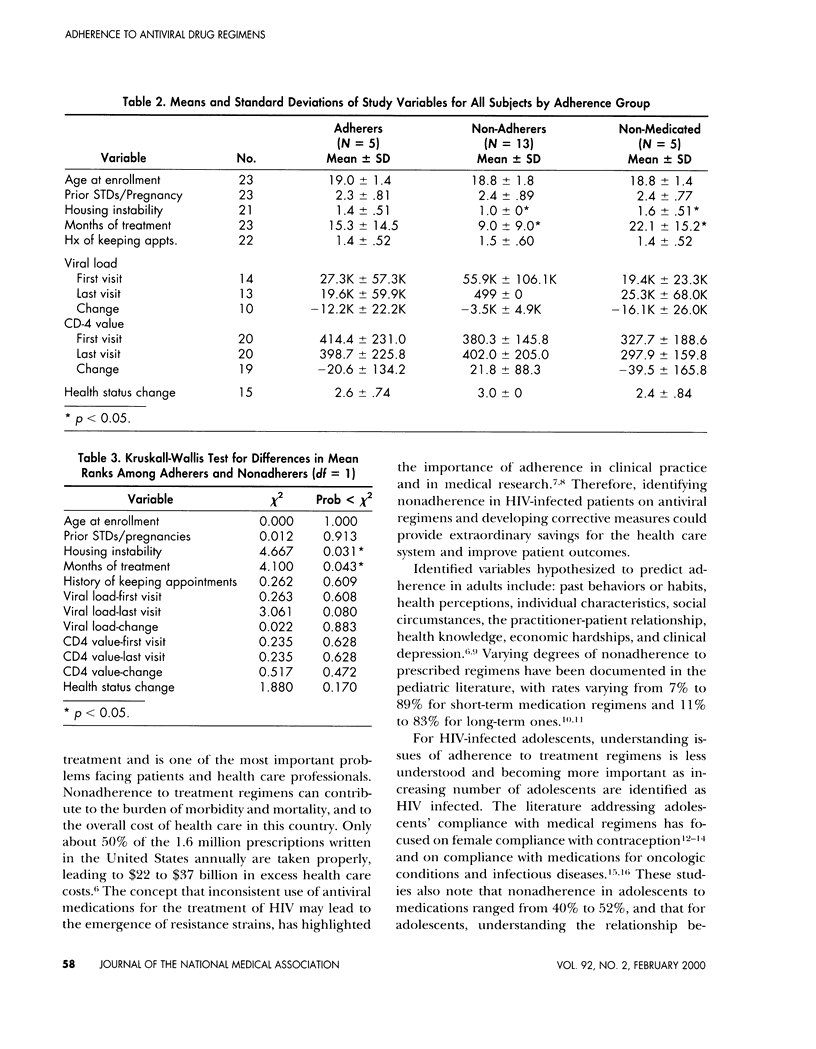
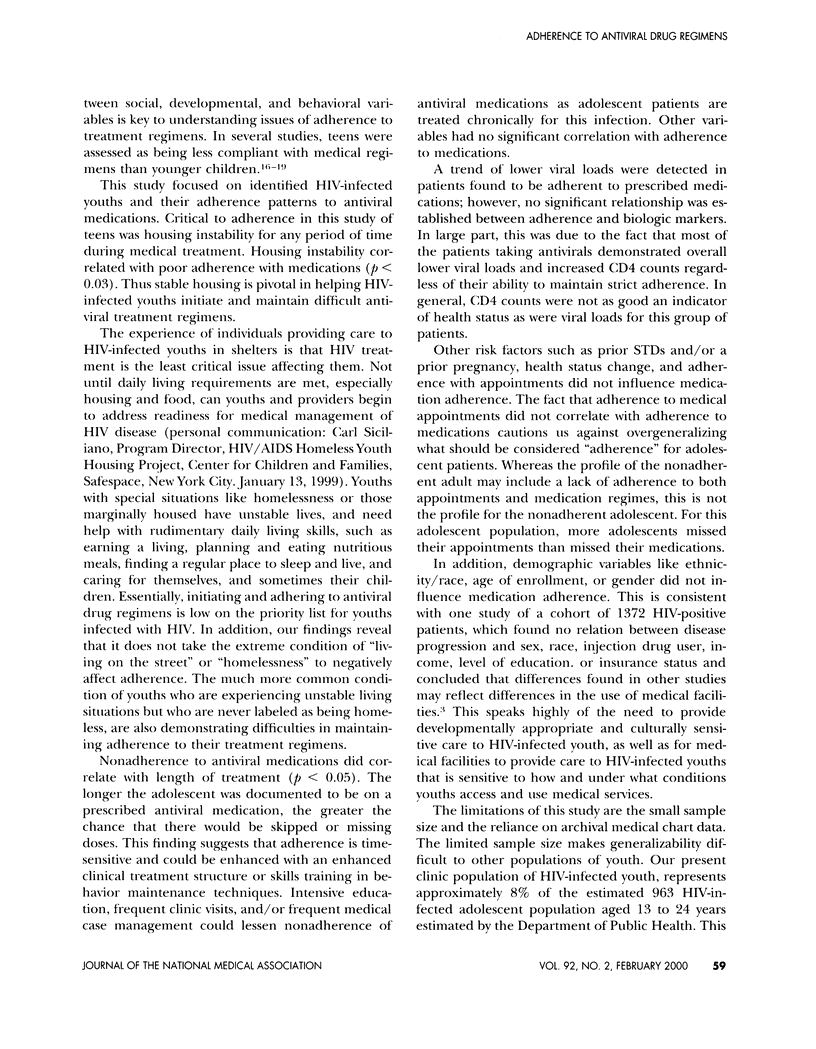

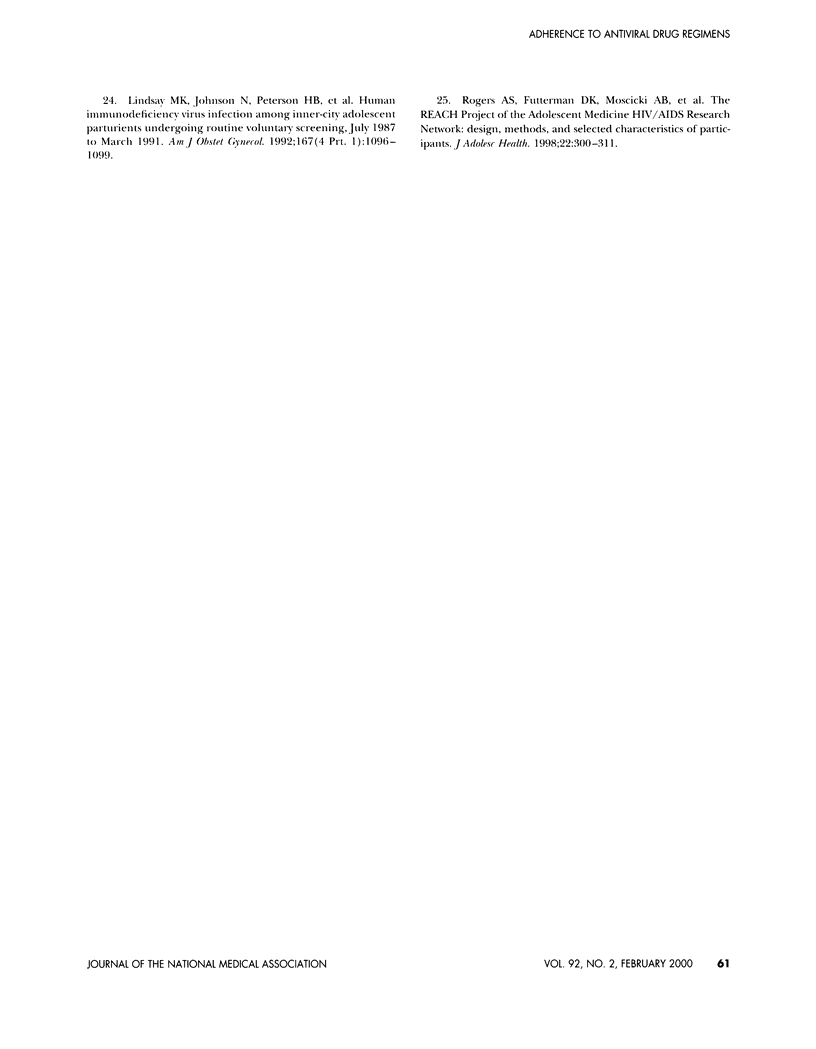
Selected References
These references are in PubMed. This may not be the complete list of references from this article.
- Bond W. S., Hussar D. A. Detection methods and strategies for improving medication compliance. Am J Hosp Pharm. 1991 Sep;48(9):1978–1988. [PubMed] [Google Scholar]
- Chaisson R. E., Keruly J. C., Moore R. D. Race, sex, drug use, and progression of human immunodeficiency virus disease. N Engl J Med. 1995 Sep 21;333(12):751–756. doi: 10.1056/NEJM199509213331202. [DOI] [PubMed] [Google Scholar]
- Conway G. A., Epstein M. R., Hayman C. R., Miller C. A., Wendell D. A., Gwinn M., Karon J. M., Petersen L. R. Trends in HIV prevalence among disadvantaged youth. Survey results from a national job training program, 1988 through 1992. JAMA. 1993 Jun 9;269(22):2887–2889. [PubMed] [Google Scholar]
- Festa R. S., Tamaroff M. H., Chasalow F., Lanzkowsky P. Therapeutic adherence to oral medication regimens by adolescents with cancer. I. Laboratory assessment. J Pediatr. 1992 May;120(5):807–811. doi: 10.1016/s0022-3476(05)80256-2. [DOI] [PubMed] [Google Scholar]
- Friedman I. M., Litt I. F. Adolescents' compliance with therapeutic regimens. Psychological and social aspects and intervention. J Adolesc Health Care. 1987 Jan;8(1):52–67. doi: 10.1016/0197-0070(87)90246-4. [DOI] [PubMed] [Google Scholar]
- Gordis L., Markowitz M., Lilienfeld A. M. Why patients don't follow medical advice: a study of children on long-term antistreptococcal prophylaxis. J Pediatr. 1969 Dec;75(6):957–968. doi: 10.1016/s0022-3476(69)80332-x. [DOI] [PubMed] [Google Scholar]
- Jay S., Litt I. F., Durant R. H. Compliance with therapeutic regimens. J Adolesc Health Care. 1984 Apr;5(2):124–136. doi: 10.1016/s0197-0070(84)80012-1. [DOI] [PubMed] [Google Scholar]
- Lemp G. F., Hirozawa A. M., Givertz D., Nieri G. N., Anderson L., Lindegren M. L., Janssen R. S., Katz M. Seroprevalence of HIV and risk behaviors among young homosexual and bisexual men. The San Francisco/Berkeley Young Men's Survey. JAMA. 1994 Aug 10;272(6):449–454. [PubMed] [Google Scholar]
- Liptak G. S. Enhancing patient compliance in pediatrics. Pediatr Rev. 1996 Apr;17(4):128–134. doi: 10.1542/pir.17-4-128. [DOI] [PubMed] [Google Scholar]
- Litt I. F. Know thyself--adolescents' self-assessment of compliance behavior. Pediatrics. 1985 Apr;75(4):693–696. [PubMed] [Google Scholar]
- Lynch J. W., Kaplan G. A., Shema S. J. Cumulative impact of sustained economic hardship on physical, cognitive, psychological, and social functioning. N Engl J Med. 1997 Dec 25;337(26):1889–1895. doi: 10.1056/NEJM199712253372606. [DOI] [PubMed] [Google Scholar]
- Matsui D. M. Drug compliance in pediatrics. Clinical and research issues. Pediatr Clin North Am. 1997 Feb;44(1):1–14. doi: 10.1016/s0031-3955(05)70459-4. [DOI] [PubMed] [Google Scholar]
- Mouton Y., Alfandari S., Valette M., Cartier F., Dellamonica P., Humbert G., Lang J. M., Massip P., Mechali D., Leclercq P. Impact of protease inhibitors on AIDS-defining events and hospitalizations in 10 French AIDS reference centres. Fédération National des Centres de Lutte contre le SIDA. AIDS. 1997 Oct;11(12):F101–F105. doi: 10.1097/00002030-199712000-00003. [DOI] [PubMed] [Google Scholar]
- Rogers A. S., Futterman D. K., Moscicki A. B., Wilson C. M., Ellenberg J., Vermund S. H. The REACH Project of the Adolescent Medicine HIV/AIDS Research Network: design, methods, and selected characteristics of participants. J Adolesc Health. 1998 Apr;22(4):300–311. doi: 10.1016/s1054-139x(97)00279-6. [DOI] [PubMed] [Google Scholar]
- Smith S. D., Rosen D., Trueworthy R. C., Lowman J. T. A reliable method for evaluating drug compliance in children with cancer. Cancer. 1979 Jan;43(1):169–173. doi: 10.1002/1097-0142(197901)43:1<169::aid-cncr2820430125>3.0.co;2-f. [DOI] [PubMed] [Google Scholar]
- Stricof R. L., Kennedy J. T., Nattell T. C., Weisfuse I. B., Novick L. F. HIV seroprevalence in a facility for runaway and homeless adolescents. Am J Public Health. 1991 May;81 (Suppl):50–53. doi: 10.2105/ajph.81.suppl.50. [DOI] [PMC free article] [PubMed] [Google Scholar]


